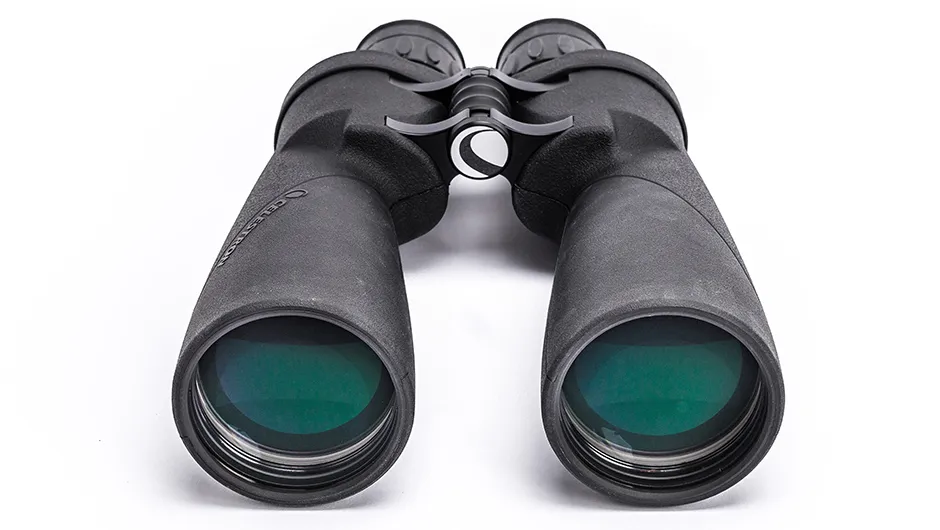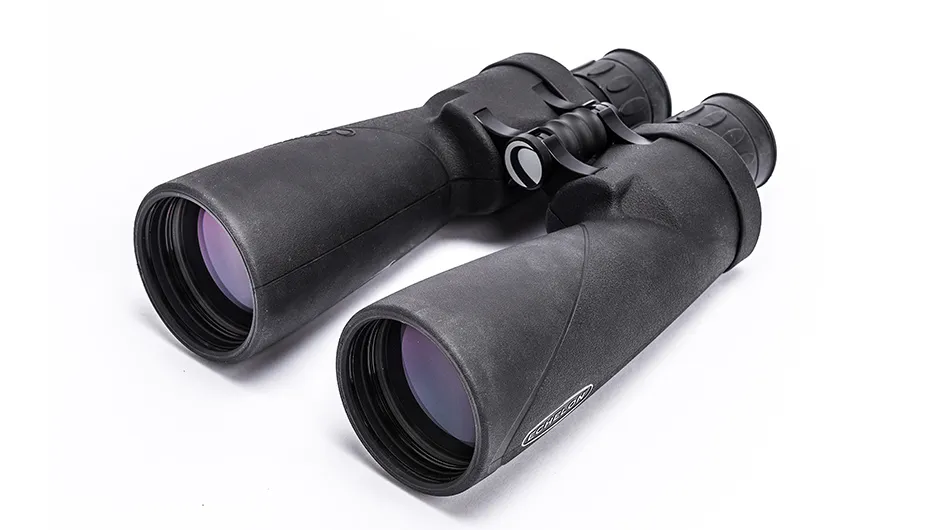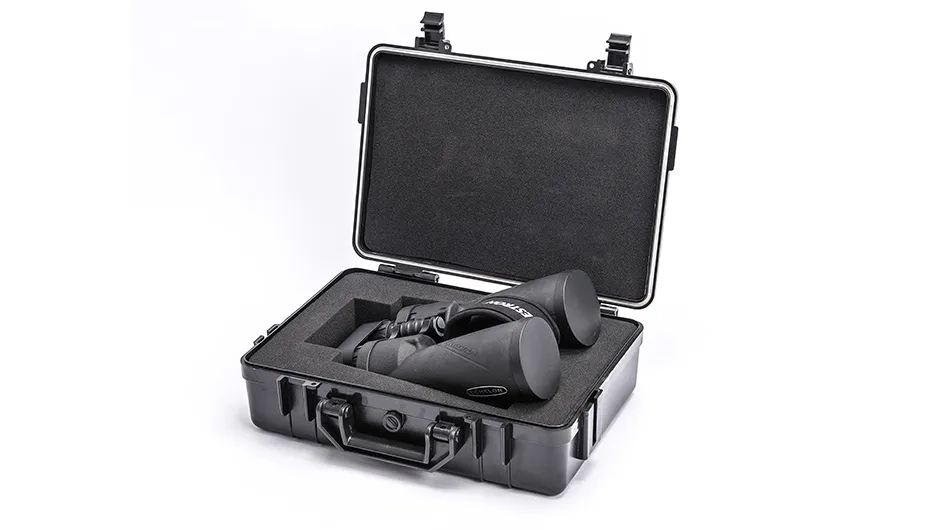Binoculars with 70mm apertures represent a substantial step up in light-gathering potential compared to handhelds with only 40mm or 50mm apertures, so when we heard about Celestron’s Echelon 16x70s –aimed at the quality end of the 70mm market – we were very keen to try them out.
The binoculars come in a rugged plastic case and are supplied with a padded neck strap, individual objective lens caps, a tethered rainguard-type eyepiece cover, microfibre cleaning cloth and an instruction leaflet that is generic to the Echelon range.
The body is aluminium alloy covered with textured rubber.
The hinge moves smoothly, with enough resistance to make it easy to adjust but not liable to sag when the binoculars are mounted.
Individual eyepiece focusing is very smooth but not as stiff as the hinge, making it easy to focus without affecting the interpupillary distance.
The minimum interpupillary distance is 58mm, but whether this is attainable in practice will depend upon the geometry of your face because at this distance there is only 8mm between the eyepieces.
The eyepiece cover limits the interpupillary distance to 62mm, so if your eyes are wider apart you will need to adjust the binoculars every time you uncover the eyepieces.
We measured the exit pupils and found them to be almost exactly 4mm.
At 16x magnification, this is inconsistent with an aperture of 70mm, and on investigation we found that although the physical aperture is 70mm the light path is internally stopped, giving an effective aperture of about 65mm.
The aim of this is usually to reduce optical aberrations and give crisper, if slightly less bright, images.
We also noticed a tiny pair of dark segments at the periphery of each exit pupil, suggesting slightly undersized prisms, but these had an imperceptible impact on image quality – which overall was very good.
The eyecups are made from a comfortable soft rubber and, folded up, permit the full 3.8° field of view to be seen.
The 18.6mm eye relief enables the full field of view to be visible without pushing the eyepieces against your spectacles when the eyecups are folded down.
These binoculars appear on our list of the best binoculars for astronomy and stargazing

Better than budget
For testing, we mounted the Echelon 16x70s on a lightweight parallelogram mount under a good suburban sky.
It ‘snapped’ to a good focus and the images from each side merged properly, showing that collimation was within acceptable tolerances.
A small amount of pincushion distortion, which manifests as straight lines at the edge of the field of view appearing to curve towards the centre, was present.
This distortion was just sufficient to prevent the nausea-inducing ‘rolling ball’ effect that can occur without it.
The on-axis colour correction was very good, although this is somewhat sensitive to eye position.
The constellation of Coma Berenices was well placed at the time of review, so we used Melotte 111 to determine limiting magnitude.
The faintest star visible with direct vision was mag. +10.1.

We then panned down to the globular cluster M53, which we could see as distinctly non-stellar.
We also observed the Moon on several occasions; it showed very good contrast on the terminator, suggesting effective control of stray light.
We used double star Iota Cancri to establish the extent of the sharp field of view: its two components are mag. +4.0 and +6.5, with a separation of 30.5 arcseconds.
We found that splitting these stars started to become difficult at 80 per cent out from the centre, and that by 90 per cent we could no longer distinguish Iota Cancri as being a double star at all.

During this test, we noticed that the brighter component appeared slightly yellow compared to the fainter one, suggesting very good colour rendition.
This was confirmed by the brilliant white of Alderamin (Alpha Cephei) contrasting vividly with the vibrant amber of Herschel’s Garnet Star (Mu Cephei), and by the colours of double star Albireo in Cygnus being the distinctive gold and sapphire that you would expect from good optics.
The Echelon 16x70s are an enormous improvement on budget 70mm binoculars and are worth considering by anyone who primarily observes with binoculars, but especially by those who need to wear spectacles while stargazing.
Well-implemented ergonomics
The one-piece construction is made from lightweight aluminium alloy, making it much lighter than is usual for binoculars of this size and quality.
Coupled with the good weight distribution, the result is an exceptionally well-balanced instrument, and it is possible to hold these binoculars by hand for quick views or when no mount is available.
To aid in this, there are smooth elliptical patches on the underside of the prism housing, which can be felt even through thick gloves, to guide your thumbs into the best position for a well-balanced grip.
The rubber armour, which is substantial and pliant enough to afford some protection against minor accidental knocks, has a texture that is non-slip even when it is wet with dew.
Allied to this, the eye relief is more than adequate, making these binoculars especially useful to people who need spectacles while observing.
Meanwhile, the curved neck strap is designed to be comfortable in extended use.
The overall result is a pair of binoculars that are extremely pleasant to explore the skies with.

Waterproof and nitrogen purged
Observing in the dewy conditions that are common in the UK brings the risk that humid air will condense inside the binoculars, eventually leading to damaging algal or fungal growth. As the Echelon 16x70s are waterproofed and filled with dry nitrogen, this source of potential damage is effectively eliminated.
Multicoatings
Celestron’s proprietary anti-reflective XLT coatings seem to be very good indeed. The minimal amount of reflection that we saw when we examined them under a bright light suggests that they have been properly applied, and confirmed that all the glass-air surfaces are multicoated. In use, we could detect no telltale ghost images from internal reflections.

Recessed objective lenses
The objective lenses are recessed 18mm into their barrels, offering some protection against damage, dew and glare. This also means it is less likely that dust will collect on the lenses or that you will accidentally touch them, thereby reducing the frequency with which they need to be cleaned.
Rugged case
The rugged plastic case is padlockable and waterproof, with a non-captive air valve that allows pressure to be equalised after, say, a journey by air. The binoculars are cradled in a cut-out in a single piece of medium-density foam. This provides very good protection for your investment.
Neck strap
The neck strap is of far better quality than is usual with binoculars of this class. The padded part is made from 6mm-thick neoprene foam and is 55mm wide. It is also curved so that there are no areas that dig into the skin when the binoculars are suspended from your neck.
Vital stats
Price: £849.00
Aperture: 70mm
Weight: 1.85kg
Supplier: David Hinds
Telephone: 01525 852696
Website:www.celestron.uk.com
This review originally appeared in the July 2015 issue of BBC Sky at Night Magazine.
